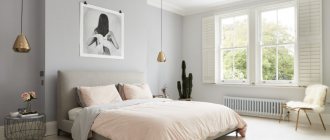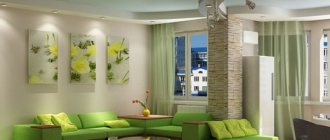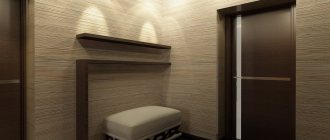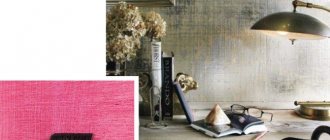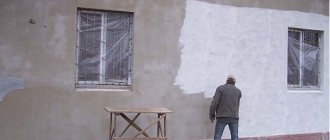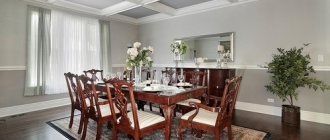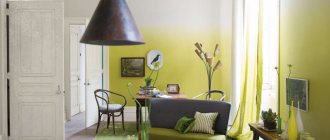3
25.05.2018
Various materials are used to decorate the corridor. A good solution would be to paint the walls. The finishing process must be carried out with full responsibility, since the hallway is considered the calling card of the house. This is the first room that guests enter when they cross the threshold of the monastery. To perform a quality finish, many issues need to be resolved. So, how to paint a hallway correctly?
What paints should I use?
To use paint and varnish material in a hallway or corridor, it is necessary to pay attention to the basic qualities and characteristics of the paint, since this will ensure long-term operation of the coatings, protect the walls from mechanical loads, the influence of liquids and other contaminants characteristic of this room.
Features of corridors and hallways:
- Location near the front door, which implies frequent sudden changes in microclimate and temperature, drafts. This destroys the coating with insufficient elasticity.
- Outerwear, shoes, umbrellas, and hats are often removed and left in the hallway or corridor. In bad weather, these things are often wet and dirty, which, as a result of moisture coming into contact with the walls, will directly put a load on the surface of the walls located close to the hangers. Paint and varnish coatings must have good wear resistance.
- Through the corridor and hallway, all objects enter the apartment: furniture, other large items. It is rarely possible to apply them without damaging the walls as a result of impact or friction, so the paint must form a durable film.
- Due to the openness of corridors and hallways to other rooms and spaces in the apartment, owners have to come into contact with evaporation from the walls, which should not be toxic or harmful. Intermediate spaces should be painted with paints intended for use in residential buildings.
Attention
Paints for hallways and corridors must have properties such as vapor permeability, safety, moisture resistance, elasticity, strength, and wear resistance.
The best paints for decorating walls in hallways and corridors are water-dispersed paint compositions. They have all the necessary properties and are vapor permeable. Let's consider the types of this category of material.
Acrylic
High-quality but expensive paints and varnishes for interior decoration. They are resistant to direct exposure to UV radiation, vapor and moisture permeability, and film strength.
Due to its high drying speed and color retention, regardless of the operating conditions of the room, the paint forms a soft, even coating that can hide even small cracks as a result of painting.
Butadiene styrene
Budget materials that are suitable only for interior work in rooms exposed to moisture, liquids, and other contaminants on the walls. It is necessary to take into account that the paints of this series are not resistant to sunlight.
As a result of prolonged contact with UV radiation, surfaces painted with water-based butadiene styrene paints acquire a pronounced yellow tint.
Polyvinyl acetate
These paint and varnish compositions are cheap, with the most modest moisture resistance indicators. They should be used in rooms where contact with moisture is minimized.
Alkyd enamel
The peculiarity of the coloring composition is the presence of toxins of organic origin. When painting a room, a persistent, very unpleasant characteristic odor is created. To eliminate this effect, you need to intensively ventilate the treated rooms for at least 3-5 days.
You can find odorless alkyd enamels at a higher price due to the composition with polyurethane-based additives.
Repair tools and materials
If painting is chosen to renovate the hallway, then even a beginner can cope with this task. You need to prepare:
- several rollers and brushes;
- paint container, small and large spatula;
- primer and putty;
- water-based paint and color of the required shade.
Water-dispersion paints are suitable for painting walls in the corridor, as they have good vapor permeability and are not afraid of water and moisture. These materials include several types of water-dispersion compositions:
- Polyvinyl acetate. This is the cheapest of these materials, which is characterized by poor resistance to a humid environment, so they can only be used for finishing dry rooms;
- Butadiene-styrene. This material is highly resistant to moisture, but has limited light fastness. Therefore, this paint is used only for interior work. Important! Styrene-butadiene water-dispersion paints are not recommended for exterior use as they turn yellow when exposed to light.
- Acrylic. These paints are more expensive than others, but their scope of application is the widest, due to their quality characteristics. This material has high moisture and vapor permeability, dries quickly, retains color in any conditions and is not afraid of ultraviolet radiation. The paint is easily applied to the surface, adheres well to the wall and allows you to smooth out small cracks up to 0.5 millimeters, resulting in an even soft coating.
Alkyd enamel can also be used for finishing the corridor. Important! Alkyd enamel contains harmful organic components, so the room will smell strongly until the paint is completely dry.
The room will need to be constantly ventilated for 3-5 days until the unpleasant odor disappears. You can also buy odorless polyurethane paints on the market, but they are very expensive and not everyone can afford to buy them.
Choosing the right wall color
In most cases, hallways are small. Basically, these are square or elongated rooms. The small area limits the choice, but there are criteria that should be taken into account:
- Area and layout of the premises. The smaller the hallway, the brighter the interior should be. A large corridor in a private house can be decorated in shades of dark colors, but for a small room it is worth choosing lighter shades.
- A stylistic direction that is used for interior design. Each style has characteristic features that you need to use to create a beautiful and stylish hallway.
- Features of the layout. In order to visually reduce a long corridor or increase the height of the ceilings, you should choose wallpaper with vertical stripes. To lengthen the room, a horizontal strip on the walls is suitable.
- Lighting affects the overall perception of the interior. Many corridors lack windows; the lack of natural light can be compensated for by placing artificial light sources. Good light will help highlight the color of the walls.
- It is not recommended to use more than 3 shades to decorate a hallway.
When choosing materials, it is worth considering the load on this functional area. Every day residents leave the house and return back. Depending on weather conditions, wet clothes, dirty shoes and wet umbrellas may appear in the hallway. Preference should be given to materials that are resistant to dirt and moisture. It would be appropriate to replace the snow-white shade of the walls with beige or cream.
Interior and lighting of the hallway Source Fashionable kitchen
Backlight
Lighting is used to zone rooms or create accents on certain details. A place with mandatory enhanced lighting is next to the mirror. You can experiment with other areas of the corridor.
Colored lighting in a hallway with plain walls will create a completely different mood. And the color of the lamp is easy to change if desired.
The color of the light source also plays an important role. Green is best used in the relaxation area, golden or pinkish in front of the mirror. Cool tones visually expand the rooms. Movable lighting fixtures will create an interesting effect in any functional area.
Before choosing what color to paint the hallway, you need to take into account all the functional features so that the color scheme improves the appearance of the hallway. A good hallway interior is very important because it sets the mood when you enter your home.
Related article: Mirrors of various shapes and types for the hallway
Hallway in white and brown tones (2 videos)
Color options for the hallway (38 photos)
How to paint the walls in the corridor: photos that are worth taking into account
Painting walls is one of the fastest and easiest ways to decorate a room and make long-awaited renovations.
However, this can be done in several ways:
- Through a variety of textures;
- Monogamous;
- Using several colors or shades.
There are simply no specific patterns, fashion trends or canons in this matter. Each homeowner chooses exactly the option that seems most attractive to him.
In order not to make a mistake with the design, it is important to think about what you would like to see in the end: a calm interior or a room with very bright accents. This desire will have to be built on in the future. Most often, corridors are painted in neutral shades, which perfectly harmonize with any interior. If desired, the boring atmosphere can be diluted with bright accessories and household items.
It often happens that inspiration does not come by itself, so it can be borrowed from the works of specialists. Their photo offers are probably freely available, so finding the right option among them will not be difficult. Such imitation will definitely be beneficial! However, you always need to make your own modifications to it. Then the design will look truly exclusive.
What do you need to prepare?
Walls
The walls in the hallway are subject to active wear and tear, so potholes, stains, chips and smudges often appear on them. The work surface can be tidied up by removing old paint or wallpaper (if necessary), using a stiff brush and soap solution (a 3% soda solution is also suitable), and leveling with putties.
If you notice that the walls have become “infected” with fungal mold, then before applying the primer you need to treat the infected areas with special chemicals. means, and then remove the layer of dead fungi. If necessary, the procedure should be repeated.
Stages of preparatory work:
1. Putty the cleaned area. Gypsum putty is usually used for this.
2. Let the putty dry completely and apply a primer.
Putty and deep primer are required! Without them, all surface imperfections will appear under the paint, and the paint itself will lie unevenly, whitish areas will remain or the texture of the paint will not appear.
Dye
Choosing the right paint for a corridor is not an easy task, given the huge range of offers from manufacturers. We will look for “vandal-proof” according to the following parameters:
- budget;
- easy to clean;
- resistant to wear;
- elastic;
- moisture resistant;
- "breathable";
- safe;
- with a high degree of adhesion.
These parameters are met by paintwork materials that combine the properties of interior and facade paints - enamels, glazes, two-component polyurethane, water-dispersion paints based on acrylic and latex.
Alkyd enamels are good, but you can only work with them with open windows and doors, because... when dry, they release a sharp pungent odor of coloring pigments, which persists for 3-5 days. There is an alkyd with polyurethane without such odors, but its prices are steep.
A washable water “dispersion” is perfect for painting walls in the hallway.
Acrylic styrene paints are also suitable for solving the problem of changing the color in the corridor. The best option in this series is butadiene dispersion for interior work.
All these paints offer many texture options: from matte glossy or shiny varnish to the effect of wet silk or soft velor.
Having finished selecting paint according to its properties, do not forget to stock up on brushes, rollers, a spray gun (according to the application technique), masking tape (for even separation of painted surfaces) and stencils if desired.
Color selection
The choice of color should be based on the preferences of the apartment residents.
If the color irritates any of them or causes frankly negative depressing impressions, it is better to refuse such paint. There are several “ideal” colors for hallways and corridors that designers recommend:
- light shades of red, lilac or green;
- powdery or pearlescent tone;
- light brown, cream, beige and others from this series.
If you are not completely sure of the color constancy for the rest of the rooms in your apartment or house, then it is best to paint the walls in the hallway and hallway in shades of light brown. By changing the intensity or other characteristics of such a coating, you can achieve a successful combination with any elements of the home.
Advice
More saturated colors should be chosen when you are confident in the stylistic decoration of the living space with such colors. This will reduce the risk of disharmony between flashy rooms and the overall interior design.
The role of color: what color to paint the hallway
Color scheme is a key point in interior design. The correct choice of colors and shades depends on the style direction, the degree of illumination, the area of the room and its intended purpose. There are no strict rules and strict criteria in the interior design of a corridor, but there are some points that should be taken into account.
The design of the corridor and the rooms adjacent to it should be compatible with each other.
The walls in the hallway can be colorful and bright, rich and expressive, or calm pastel; only white should be avoided.
Today, the most popular are classic shades for decorating a hallway.
The role of color in the interior of the hallway:
- Classic shades (light brown, cream and beige) will make the room practical.
- Light gray, for example, is a color that can visually expand a room; moreover, it easily combines with more saturated shades.
- In any interior it is important to combine no more than 3 colors so as not to overload it with bright colors.
When choosing a color for the hallway walls, it is very important to pay attention to the existing furniture. It should be combined with the selected shade. When purchasing new furniture for the corridor, it is important to maintain a single style: for classic furniture, red or black walls are definitely not an option, just like pink for minimalist furniture. The selected furniture should be several shades darker than the walls, but not gloomy. If the choice is made for a black hallway, you should play it up with lighter colors.
Properties of hallway paint
In order for the finish to remain attractive for a long time and protect the walls well, you should pay attention to the conditions in which it will be used.
Features of hallways and corridors can be listed as follows:
- The proximity of the street, constant drafts, and frequently opening doors lead to constant temperature changes in the room. Because of this, the material must be elastic in order to adequately respond to such changes and cope with expansion;
- High loads on the finishing are associated with the fact that people will constantly change clothes in this room, outer clothing will come into contact with the walls, dirtying and moistening them, and splashes from shoes can fall on the lower area of the walls. That is why the finishing layer must be wear-resistant;
- All items in the apartment get there through the corridor (materials for construction, furniture, sleds, various equipment, and so on). When transporting such objects, friction, impacts and other mechanical impacts on the walls often occur. This means that the finishing layer must be strong enough;
- The hallway is part of the apartment, so it can also be classified as a residential area. Based on this, finishing materials should not contain poisons and toxins, as well as other substances that can harm human health. In addition, the finishing should allow the walls to breathe and release steam.
Attention: It can be concluded that the paint for the hallway must be durable and wear-resistant, elastic and moisture-resistant. Plus, it must be safe and allow steam to pass through.
Decorating with natural materials
Walls covered with wooden panels in the hallway are still a rarity, but this bold decision looks very advantageous in corridors of any type. What effect can such walls create? Thanks to the variety of shades and natural structure of wood, you can create a unique interior.
Wood will not only decorate, but will help solve several problems. You won't have to level the walls because the panels will hide minor unevenness. The room will not need to be insulated, which is especially important in drafty hallways.
Natural materials look great in the right lighting. Wood needs warm, diffused light, while stone requires bright, directly incident rays.
An equally interesting material is stone. Of course, if you cover all the walls with it, it will look gloomy, but individual areas will blend harmoniously with the interior. It is better to choose the type of stone depending on what color you have chosen to paint the rest of the wall.
It is important to consider the style of the room. In classic and country style, wood would be appropriate, while modern, retro and minimalism gravitate more toward stone. If your interior is in high-tech style, then it is better not to use such finishing.
Choosing a color for a narrow hallway
A narrow corridor seems inconvenient to many. Only place cabinets along the walls, which, by the way, are constantly getting dirty. Pasted wallpaper often breaks because it gets touched by bags and outerwear, so the best option is to paint the walls.
Related article: Decorating the hallway and corridor in a modern apartment (+35 photos)
A narrow corridor imposes certain restrictions on the selection of colors. The main rule is not to overload the corridor with an abundance of flowers.
It is important to make a narrow corridor well lit not only through lamps.
White would be an excellent solution, but its downside is impracticality. This does not mean that it cannot be used in the hallway at all. A snow-white finish on a burgundy or dark blue background will look very impressive. If you do not want such experiments, it is recommended to choose light and delicate colors. Pay attention to the cool color scheme, which will help create a feeling of airiness in the interior.
Avoid monotony, it will tire you. You can create a smooth transition from a light shade to a darker one throughout the entire corridor. Another solution is to create an interesting texture on the walls, such as plastering before painting.
Decoration for a small hallway
Small rooms require a particularly careful design approach. What color should I paint the room? It is not recommended to make the walls in such hallways monochromatic. For visual expansion, it is recommended to use horizontal stripes. Vertical lines will correct low ceilings, visually lifting them. The pattern does not always have to be straight lines; a pattern directed horizontally or vertically is sufficient.
The color scheme in a small corridor should not be too dark. It is best to paint in light cinnamon and beige shades with white and off-white trim. An interesting solution would be white and brown striped teeth. A white horizontal stripe on the wall under the ceiling will visually raise it. You can also use mirrors and metal trim pieces to expand the space.
Small rooms are very capricious in terms of design. The emphasis should be on functionality, but at the same time avoiding exaggerated minimalism.
Natural materials look good in a small apartment. Light wood trim will create a warm and cozy atmosphere, and if installed correctly, it will last for many years.
Related article: Decorating a small hallway: selection of materials
How to choose a hallway decor in dark colors
If the hallway is large enough, its interior can be made in dark colors. Having chosen the appropriate black style (noir, gothic), the designer must take into account the following restrictions:
- There is no natural light in the hallway. Crossing the threshold of an apartment in the evening, a person finds himself from the light street twilight into a darker space. In the absence of constant illumination in front of the light switch, the person entering is doomed to search for the treasured button by touch. If the switch is located far from the front door, then the task becomes even more complicated.
- Visual narrowing of space disorients a person. It is undesirable to place large mirrors and fragile decor in a dark hallway. Mirrors will further distort the perception of reality, and sharp glass or heavy decor is inherently dangerous.
- Excessive shading guarantees household members periodic tripping over floor elements and low furniture. To avoid troubles, it is recommended to exclude pouffes, chairs, benches and hangers with wide legs from the decor. It is better to move the shoe rack to the closet.
Some types of gothic and noir fascinate fans with their mystery and otherworldliness. But such beauty requires special operating rules from the owner of a dark hallway. In addition, the refusal of important furniture elements for the seat can significantly reduce the level of comfortable living. The only practical advantage of dark styles is ease of maintenance. The spots of dirt that appear on the walls are practically invisible.
Gothic style
DIY surface painting
Let's look at how to beautifully and correctly paint a surface. Before finishing, a style is determined, which will dictate the number and type of wall covering colors used. Popular:
- Rococo - golden, pink, cream shades are combined.
- High-tech - reflected in elements and coatings of monochrome, metallic tones.
- Minimalism is a combination of pastel, black, pure white colors (how to paint a wall white?).
- Baroque is one of the luxurious styles that requires finishing in turquoise, blue and white colors.
- Modern, classic - created by a combination of pastel, green, white shades.
Most of all, the type of style is influenced by the number of square meters of the corridor and hallway. This must be taken into account so that the decoration does not look ridiculous or have a contradictory effect.
The number of main color finishes is arbitrary, but most often does not exceed three. The geometry and size of the room influence this indicator. For cramped hallways and corridors, it is recommended not to overload with colors, use no more than two with vertical or horizontal stripes to create the desired visual effect.
Large hallways can be painted in several colors, since they play with geometry and even zone. You need to adhere to the principle of combining three shades so that the interior remains cozy.
In a small room
Tight spaces should be finished only with safe compounds, since the likelihood of contact with the surface of the walls is very high.
How to choose materials for decorating a small corridor or hallway:
- It is better to use 2 colors to create the effect of expanding the space.
- The corridor will be made higher by applying vertical lines alternating with the main tone of the coating.
- Panels mounted horizontally or decor that differs from the main color of the finish can create the impression of a wider space.
- Dark tones will make small rooms even more cramped, so preference should be given to light shades of brown and beige with decorative inserts in white and milky tones.
- By applying a white stripe 10-20 cm wide under the ceiling, you can visually raise it a little.
- The use of chrome elements and mirrors is another way to create the illusion of more space than it actually is.
- To create a cozy and warm atmosphere, wood or other natural materials are very good.
Important
An entrance hall or corridor is a functional space designed to keep an apartment or house clean. It is necessary to think very carefully about the arrangement of furniture and decor in order to achieve the optimal combination of space and spaciousness of objects.
In the large hallway of the apartment
The advantage of large hallways and corridors is the variety of design solutions. In a spacious room, you can create a design with bright expression, zoning or color accents. For a classic style, paints in olive, turquoise, green or delicate light green shades are suitable.
Creative and daring individuals will appreciate designs that include contrasting color combinations. It is necessary to take into account the combination of shades with each other when designing, so it is better to entrust the selection to a designer. The basis of contrast is the combination of colors for the walls and their selection for finishing the floor and ceiling.
On your own or with the help of professionals
Options for doing repair work yourself are good in their own way, but very expensive in terms of human resources. Only those who are confident in their abilities and are not afraid to struggle with difficulties should take up work.
Whatever the design option for the corridor, it can be implemented in two ways:
- On one's own;
- Through people of the relevant profession.
There is no need to talk about the advantages of the second option, because real specialists are accustomed to working conscientiously. They will carry out the entrusted range of work quickly, efficiently and, if necessary, even give practical advice. However, all good things in life come at a price. And quite a lot.
The corridor is a kind of calling card of the house. Not only is this the first room that guests and owners enter when entering the house, but it is also subject to greater wear and tear. In order for the repair to last a long time, and for the walls to be beautiful and well-groomed, you need to know how to paint the corridor correctly and what materials to choose for this.
All kinds of water-based paints are perfect for covering the walls of the corridor in the house. Today, such materials are presented in a wide range of prices, which determines their quality accordingly. Most often the paint is sold in white. However, you can add a special color to it, which will give the paint the desired shade. Important! Experts advise painting the walls below in darker shades, and moving to lighter shades at the top.
What does it look like in the photo?
In the following photo you can see what the painted room looks like.
Painting the corridor
For those who decide to paint the walls in the hallway with their own hands, we provide detailed instructions:
Applying dye
- First, the walls must be rid of the old coating. The paint can be removed with special means or scraped off. A grinder equipped with a metal brush will do. It’s easier to remove wallpaper; we simply moisten it with water and work with a spatula;
- We carefully inspect the surface; if there are any flaws, they must be eliminated using putty. We beat back plaster that is crumbling (see How to strengthen crumbling plaster with your own hands) and immediately repair it using a cement solution or putty;
- A leveling layer of gypsum putty is applied to the wall. After drying, it is necessary to cover everything with a small layer of finishing putty;
- The entire surface is rubbed with a grater and emery, trying to polish everything as efficiently as possible. As a result, the surface should be smooth;
- We remove dust, vacuum everything around, apply an acrylic primer with deep penetration;
- As soon as the soil dries, proceed to the first layer. Using a brush, rub in a thin layer of paint;
- After the initial layer has dried, take a roller and apply the next one. Finally, the wall is covered last.
- If you have a large surface, then use a spray bottle (see Selecting a spray bottle for painting). Then the work will not take much time. Also in this case, you should not hold the spray gun perpendicular to the wall. Then there will be leaks. The paint should be applied at a slight angle.
Attention: Do not forget about the masking tape, with which you can make smooth borders and not stain adjacent areas.
Now you’ll figure out how to paint the walls in the hallway. If you do the work yourself, the price will not be high. You have instructions on the rules for choosing dyes. After looking at the photo, you can quickly decide on the choice of dye.
Expert advice
For painting you will need to prepare equipment and materials:
- water-based or water-based paint;
- color matching;
- putty in case of unevenness on the surface of the walls that needs to be eliminated (how to putty and evenly paint the walls?);
- acrylic-based deep penetration primer;
- spatulas of different sizes;
- container for diluting paint;
- rollers, brushes or spray gun.
Designers offer the following tips when choosing the style of design and decoration of walls in the corridor and hallway:
- To highlight the features of a room, its advantages, and hide minor flaws, you need to choose a method for painting surfaces.
- Decorate small and cramped rooms in light shades and add mirror elements. This will visually increase the perception of space.
- To create an original interior, stencils are suitable, which will create unusual contrasting patterns against the general background of the walls.
- It is best to decorate spacious corridors and hallways in several colors using zoning methods.
All work can be completed without the help of craftsmen, if you approach the selection of paint and interior style responsibly. Determine the method of applying coloring compositions, which can significantly facilitate all work and achieve the desired visual effects. The main rule for painting hallways or corridors is a combination of colors in accordance with the geometry of the room, lighting and the way it is used.
Is it possible to do everything yourself?
Making renovations yourself is easy, especially when it comes to painting walls. Following the rules of design and the sequence of work, they create an original design. Particular attention should be paid to preparing the surface for finishing. The wall is leveled and treated with a primer solution before painting.
Today, paintable wallpaper is very popular. If desired, the color of the walls can be easily changed. To achieve the desired result, it is necessary to take a responsible approach to the choice of material and finishing.
What is better to use for the walls in the hallway: wallpaper or paint?
Wallpaper is considered to be a more environmentally friendly and convenient tool for interior design. Painting walls is a largely tedious, slow and unclean task. However, during long-term use, paint outperforms wallpaper in many ways. Scratches, dirt and deformations that appear on the painted surface can be easily removed by refreshing the wall surface with a new layer of paint. Replacing damaged wallpaper will be much more difficult. For decades, designers have been unable to prioritize paint or wallpaper. In 2021, such a dilemma begins to lose its relevance. Advanced technologies have given designers overlay surfaces made of various materials. Directly at the factories, at the customer’s request, the overlay surface will be decorated with any pattern.
Green hallway with white doors
If you still have questions after reading the article “What wall color to choose for the hallway ,” ask them in the comments, we will definitely try to supplement the material with answers to them.
Fashionable design solutions in 2021 (photo selection)
Let's look at the fashion trends in hallway design for this year:
- When creating the interior of a hallway, it is important to plan the arrangement of furniture. Since there are few free walls left, finishing plays a secondary role.
- Repair is made difficult by a large number of items. Be smart and embrace minimalism.
- Use no more than three colors for finishing: wood, white, gray or dark. Everything in the hallway has its own colors, for example, a wood floor, a snow-white ceiling, a dark rug. These colors are present in almost every interior. If you bring in bright colors, it will look pretentious and ridiculous.
- The hallway with built-in furniture and hidden LED lighting matches the fashionable design.
When decorating a small corridor, the priority should be neatness and functionality. Make the background in neutral colors, and we recommend choosing decorative plaster for finishing materials. It is reliable, stains are not visible on it, and is easy to clean. If you wish, you can choose wallpaper for painting or painting. If you have a spacious hallway or are planning a redevelopment, then the design will be completely different. For finishing you can choose several materials.
Textured surfaces add variety to the interior of a gray hallway. The texture can be created using decorative plaster.
When designing a corridor, its functionality comes first, and its elegant appearance, comfort, and convenience come second. It is important to observe moderation in everything.
